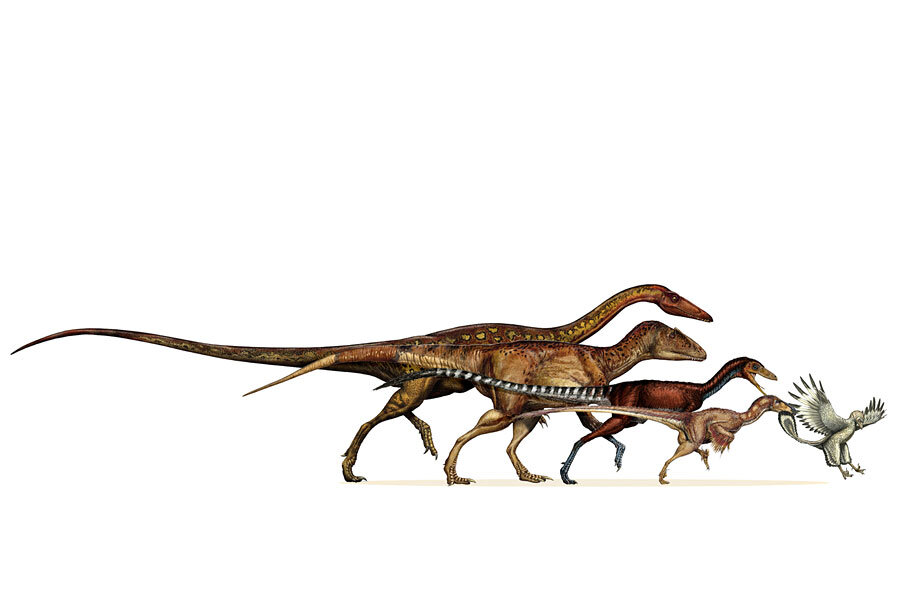A story for the birds? The incredible shrinking dinosaur
For decades, paleontologists have been uncovering the remarkable evolutionary relationships between fearsome, two-legged, meat-eating dinosaurs and birds.
A new study suggests that the pace of the transition from one to the other was quick by dinosaur standards. In the 50 million years preceding the appearance of the first birds some 163 million years ago, the size and weight of theropods along the direct line of descent to birds shrank one group after another – slowly at first, but going into free fall during the final 10 to 15 million years once Maniraptors took the evolutionary baton from their direct ancestors, the Coelurosaurs.
The skeletal changes taking place during the 50-million-year dinosaur-to-bird transition were occurring four times faster than for dinosaurs as a whole, according to the analysis, conducted by an international team of researchers led by Michael Lee, with the South Australia Museum in Adelaide.
Rapid rates of change in body size have appeared before in the fossil record. Following a mass extinction at the end of the Cretaceous period some 65 million years ago, an event that drove non-avian dinosaurs extinct, the size and diversity of mammals exploded over a 15-million-year period, researchers say. This came as mammals began to fill ecological niches vacated by the late, great dinosaurs.
The interplay between evolution and ecological niches was likely at work for the ancestors to birds as well – in this case, the Great Escape.
Some researchers surmise that the changes in body size and skeletal structures that led to the first birds, particularly during the phase of accelerated change, could have occurred as the now-smaller theropods moved into trees to escape becoming another animal's meal or to take advantage of new sources of food.
The continuing reduction in size needed to succeed as tree dwellers would have triggered a cascade of evolutionary changes, suggests University of Bristol paleontologist Mike Benton. These changes would have improved vision, improved the aerodynamics of forelimbs to allow for increasingly ambitious leaps from tree to tree, or encouraged the evolution of feathers to insulate the new tree dwellers.
"Being smaller and lighter in the land of giants, with rapidly evolving anatomical adaptations, provided these bird ancestors with new ecological opportunities," Dr. Lee said in a prepared statement.
Past studies of animal sizes in the run-up to birds had looked at individual branches of the avian ancestral tree or used trees that used physical traits to establish relationships, but no dates.
Lee and colleagues were able to take advantage of the explosion of small feathered theropod fossils coming out of China since the mid-1990s, known collectively as Paraves. These animals were trying to exploit various ways of getting from tree to tree – jumping, gliding, or parachuting, notes Dr. Benton in an article in the current issue of the journal Science. The article accompanies the analysis Lee and his colleagues performed.
The researchers gathered data on 1,549 skeletal traits from 120 species of theropods, including the length of the thigh bones and the ages of the specimens. The team used the femur as a marker of body mass. They then applied sophisticated statistical techniques to reconstruct the relationships among the species, their chronology, and track their evolutionary changes.
Some 200 million years ago, direct ancestors of the first birds tipped the scales at about 360 pounds. By about 175 million years ago, the typical weight of a new generation of direct ancestor had fallen to 100 pounds. Over the next 10 million to 15 million years, body weights would plummet, winding up at about a pound for the first birds.
The study is significant on two levels, suggests Daniel Field, a PhD candidate in paleontology at Yale University and a predoctoral fellow at the university's Peabody Museum of Natural History.
Researchers have a good idea of what the pattern of evolutionary relationships are along that lineage, he says, "but we don't have quite as good an idea of how those evolutionary transitions actually played out," he says. The analysis Lee and his colleagues have performed help fill in that information.
But the study has broader implications, Mr. Field adds. The team amassed a remarkable set of data that will be valuable in its own right and raises additional, intriguing questions.
For instance, the Great Jurassic Shrink Off was apparent at each of 12 or more points along the main line of evolution between theropods and birds. Those points represent branches in the family tree where other theropods went off in their own evolutionary directions – directions in which body size either remained stable or often increase significantly, in one case giving the world Tyrannosaurus rex. It's a pattern that repeats along each branch. Explaining that repetition even as the avian lineage was yielding ever smaller animals over the same time span is a fresh mystery the data present, according to Field.






